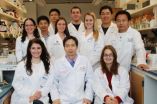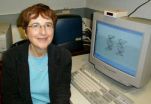(Press-News.org) CINCINNATI—A University of Cincinnati (UC) cancer biology team reports breakthrough findings about specific cellular mechanisms that may help overcome endocrine (hormone) therapy-resistance in patients with estrogen-positive breast cancers, combating a widespread problem in effective medical management of the disease.
Xiaoting Zhang, PhD, and his colleagues have identified a specific estrogen receptor co-activator—known as MED1—as playing a central role in mediating tamoxifen resistance in human breast cancer. The team reports its findings in the Nov. 1, 2012, issue of Cancer Research, a scientific journal of the American Association for Cancer Research.
According to the National Cancer Institute, nearly 227,000 women are diagnosed with breast cancer annually in the United States. About 75 percent have estrogen-positive tumors and require adjuvant hormone therapy such as tamoxifen, a drug that works by interfering with estrogen's ability to stimulate breast cancer cell growth.
Despite advances in hormone therapy drugs, cancer surveillance research has shown that 50 percent of patients will develop resistance to the drug and experience a cancer relapse.
The hormones estrogen and progesterone can stimulate the growth of some breast cancers. Hormone therapy is used to stop or slow the growth of these tumors. Hormone-sensitive (i.e., positive) breast cancer cells contain specific proteins known as hormone receptors that become activated once hormones bind to them, leading to cancer growth.
Based on new findings, UC Cancer Institute scientists believe that tamoxifen resistance may be driven by a novel molecular "crosstalk" point between the estrogen and HER2 (human epidermal growth factor receptor 2) signaling pathways.
Testing in both pre-clinical models and human breast cancer tissue samples showed that MED1 co-amplifies and co-expresses with HER2, a gene that has an increased presence in 20-30 percent of invasive human breast cancer and plays a major role in tamoxifen resistance.
HER2 over-expression led to MED1 activation while reduction of MED1 caused breast cancer cells that were otherwise tamoxifen-resistant to respond and stop dividing. Further mechanistic studies showed that HER2 activation of MED1 resulted in the recruitment of co-activators instead of co-repressors by tamoxifen-bound estrogen receptor. This, explains Zhang, drives expression of not only traditional estrogen receptor-positive cancer target genes, but also HER2 and those estrogen receptor target genes abnormally activated by HER2.
"Together, these findings suggest this 'crosstalk' could play a central role in mediating tamoxifen resistance in human breast cancer, especially because recent published data also indicated that high MED1 expression levels correlate with poor treatment outcome and disease-free survival of patients who underwent endocrine therapy," explains Zhang, an assistant professor of cancer biology at the UC College of Medicine and breast cancer researcher with the UC Cancer Institute.
"We are currently utilizing RNA-based nanotechnology to target MED1 in an effort to simultaneously block both estrogen and HER2 pathways to overcome endocrine-resistant breast cancer."
INFORMATION:
UC study collaborators include cancer biologists Jiajun Cui, PhD, Katherine Germer, MD, Shao-chun Wang, PhD; environmental health researcher Tianying Wu, PhD; and pathologist Jiang Wang, MD. Qianben Wang, PhD of the Ohio State University College of Medicine, and Jia Luo, PhD, of the University of Kentucky, also contributed to this study.
The study was supported with startup funding from the UC Cancer Institute, Ride Cincinnati/Marlene Harris Pilot Grant, Susan G. Komen for the Cure Foundation and the Center for Clinical and Translational Science and Training—home to UC's institutional Clinical and Translational Science Award program grant from the National Institutes of Health.
New finding gives clues for overcoming tamoxifen-resistant breast cancer
2012-11-02
ELSE PRESS RELEASES FROM THIS DATE:
Active surveillance can reduce suffering among men with prostate cancer
2012-11-02
With active surveillance many men with prostate cancer could dispense with radiation treatment and surgery, and thus avoid adverse effects such as incontinence and impotence. This is the outcome of a study of almost 1,000 men diagnosed with prostate cancer conducted at Sahlgrenska Academy, University of Gothenburg, Sweden.
The introduction of PSA tests, which are used to screen for prostate cancer, offers early tumour detection, reducing mortality rates. At the same time, prostate cancer is in many cases a slow-growing form of cancer. Many men may never develop symptoms ...
Don't ignore doubts about marriage, researcher warns
2012-11-02
Couples about to tie the knot shouldn't ignore nagging doubts about getting married, warns a University of Alberta researcher.
"If you are having doubts about the relationship, just ignoring them may make a difference years down the road," said Matthew Johnson who co-authored the study while at Kansas State University. Johnson is now an assistant professor in the University of Alberta Department of Human Ecology.
The study, published recently in the journal Family Process, found that couples who were more confident as they exchanged vows also spent more time together ...
Cannabis use mimics cognitive weakness that can lead to schizophrenia
2012-11-02
Researchers at the University of Bergen in Norway have found new support for their theory that cannabis use causes a temporary cognitive breakdown in non-psychotic individuals, leading to long-term psychosis. In an fMRI study published this week in Frontiers in Psychiatry, researchers found a different brain activity pattern in schizophrenia patients with previous cannabis use than in schizophrenic patients without prior cannabis use.
The results reinforce the researchers' model where cannabis users suffering from schizophrenia actually may have higher cognitive abilities ...
World record for the entanglement of twisted light quanta
2012-11-02
To this end, the researchers developed a new method for entangling single photons which gyrate in opposite directions. This result is a first step towards entangling and twisting even macroscopic, spatially separated objects in two different directions. The researchers at the Vienna Center for Quantum Science and Technology (VCQ), situated at the University of Vienna, and the Institute for Quantum Optics and Quantum Information (IQOQI) at the Austrian Academy of Sciences have were able to get their pioneering results published in the current issue of the renowned scientific ...
Grading US presidents on the economy
2012-11-02
During presidential campaigns, it's not unusual to hear candidates from both parties say they will focus on strengthening the nation's economy. But how well have presidents delivered on that promise once in the White House?
On a newly-released report card that grades presidents on their economic performance, Franklin D. Roosevelt, Warren G. Harding and Rutherford B. Hayes are at the top of the class, while Chester Arthur, Herbert Hoover and Martin Van Buren receive failing grades.
The first-of-its-kind study by the Georgia Institute of Technology analyzed up to 220 ...
Cancer bound
2012-11-02
A person doesn't have to go far to find a polycyclic aromatic hydrocarbon (PAH). These carcinogen precursors are inhaled through automobiles exhaust during the morning commute, are present in a drag of cigarette smoke, and are part of any barbequed meal.
Once ingested or inhaled, these big, bulky multi-ringed molecules are converted into reactive carcinogenic compounds that can bind to DNA, sometimes literally bending the double helix out of its normal shape, to form areas of damage called lesions. The damaged DNA can create errors in the genetic code during replication, ...
Navy researchers look to rotating detonation engines to power the future
2012-11-02
WASHINGTON--With its strong dependence on gas-turbine engines for propulsion, the U.S. Navy is always looking for ways to improve the fuel consumption of these engines. At the Naval Research Laboratory (NRL), scientists are studying the complex physics of Rotating Detonation Engines (RDEs) which offer the potential for high dollar savings by way of reduced fuel consumption in gas-turbine engines, explains Dr. Kazhikathra Kailasanath, who heads NRL's Laboratories for Computational Physics and Fluid Dynamics.
Many Navy aircraft use gas-turbine engines for propulsion, with ...
Solar system's birth record revised
2012-11-02
Some 4.567 billion years ago, our solar system's planets spawned from an expansive disc of gas and dust rotating around the sun. While similar processes are witnessed in younger solar systems throughout the Milky Way, the formative stages of our own solar system were believed to have taken twice as long to occur. Now, new research lead by the Centre for Star and Planet Formation at the Natural History Museum of Denmark, University of Copenhagen, suggests otherwise. Indeed, our solar system is not quite as special as once believed.
Using improved methods of analysis of ...
Disaster defense: Balancing costs and benefits
2012-11-02
Do costly seawalls provide a false sense of security in efforts to control nature? Would it be better to focus on far less expensive warning systems and improved evacuation procedures that can save many lives?
Seth Stein, a Northwestern University geologist, has teamed up with his father, Jerome Stein, an economist at Brown University, to develop new strategies to defend society against natural disasters like Hurricane Sandy as well as the effects of climate change.
The approach, which considers costs and benefits while looking for the best solution, is based on a ...
Were dinosaurs destined to be big? Testing Cope's rule
2012-11-02
Boulder, CO, USA – In the evolutionary long run, small critters tend to evolve into bigger beasts -- at least according to the idea attributed to paleontologist Edward Cope, now known as Cope's Rule. Using the latest advanced statistical modeling methods, a new test of this rule as it applies dinosaurs shows that Cope was right -- sometimes.
"For a long time, dinosaurs were thought to be the example of Cope's Rule," says Gene Hunt, curator in the Department of Paleobiology at the National Museum of Natural History (NMNH) in Washington, D.C. Other groups, particularly ...



